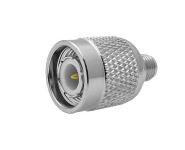Where to enable and disable. How to enable and disable macros in documents
So it's time to resume our simple lessons on using the iPhone. Today we will learn how to turn iPhone on and off. If you already know how to do this, you can skip this article.
Let's look at a few situations in which we need to turn our device on and off. This usually happens in the following cases:
- We bought new smartphone and don't know how to turn it on and off.
- The iPhone stopped responding and froze.
- Power button broken
We bought a new smartphone and don't know how to turn it on and off/off
In this case, the first thing to do is to familiarize yourself with the device from all sides. Pay attention to the picture below, it shows all the elements of our phone.
Turn on
To enable we need a button "Sleep/Wake Mode" or Power. On iPhone 5 and up to 6, the button is on the top, and on iPhone 6 versions, on the right. Pay attention to the photo below.

Turn off / Turn off
Press and hold the button to turn on the iPhone "Sleep/Wake Mode" within a few seconds.
To turn off the iPhone, you must repeat the same steps, after which the shutdown bar will appear on the screen, as in the figure below. Just swipe on it and the smartphone will turn off.

iPhone stopped responding and froze
In order to turn off the phone in this state, you must simultaneously press and hold the buttons "Sleep/Wake Mode" And "Home" see photo below. After a few seconds, the phone will turn off. After waiting for a while, it can be enabled using the method described above. Don't be alarmed if it takes longer than usual to turn on, this is necessary for the phone to correct errors.

The power button is broken ("Sleep / Wake Mode")
There are situations when the aforementioned button stops working on the phone, but this is not a problem either. In this state, we need to activate the function "Assistive Touch". For this we go to "Settings" -> "General" -> "accessibility" -> "AssistiveTouch" and switch the slider to "On".
A circle will appear on the screen, as in the photo below. Click on "Apparatus" / "Device" -> "Lock Screen" / "Lock Screen". A power off bar will appear on the screen, swiping it will turn off the phone.

Perhaps many of the users of stationary personal computers wondered how to organize automatic switch on And shutting down the computer V given time or on schedule. In this article, we will consider one of the more accessible methods.
To implement this function work personal computer we will use exclusively the built-in capabilities of the BIOS input / output system and operating system Microsoft Windows 7. Usage software third-party manufacturer is excluded by itself.
We define a schedule that consists of necessary conditions, i.e. we need the personal computer to turn on every weekday at 07:00 am and turn off at 17:00 pm. Regarding weekends, due to a limitation in the BIOS input / output system, the computer will start at 07:00 in the morning and turn off after 10 minutes as unnecessary, because. no one is at work.
So, let's begin. When you turn on the computer, you need to enter the BIOS input / output system. To do this, press the key "DELETE", this key is mainly used in many motherboards, but there are still other uses of the keys, such as:
Esc F1 F2 F3 F10 F11 F12
After pressing the "DEL" key, the BIOS system menu will be displayed and will look something like the one shown in the figure below:

Set the value of the "Resume by Alarm" parameter to , activating the computer to turn on according to the schedule. In the “x Date (of Month) Alarm” parameter, you can select a daily execution or specify the desired day of the month, in our case we will use the first one - Everyday. Computer turn-on time "x Time (hh:mm:ss) Alarm" is defined as 07:00 am.
Thus, automatic switch on personal computer organized according to the schedule: daily inclusion at 07:00 in the morning, both on weekdays and weekends.
Computer shutdown settings
Now we need to create a schedule for automatic shutdown personal computer. The built-in console file will help us with this. taskschd.msc, the so-called "Task Scheduler", which will perfectly cope with the task. Task Scheduler can be launched using the "Search programs and files" line and "Explorer" Windows.
Method 1 - "Find programs and files"

2 way - "Explorer"

After the above commands, the "Task Scheduler" will open, in which you need to go to the "Task Scheduler Library" item and take the action to create a task - "Create a task" or "Create a simple task", as you like. Detailed description We will not describe how to create a task, everything is available and written in Russian.

As you can see, in the figure below, two tasks are created that produce automatic shutdown personal computer. The first task called “OFF PC” organizes PC shutdown on weekdays at 17:00, and the second task named as “OFF PC Weekend” performs PC shutdown on weekends 10 minutes after turning on the PC.

The detailed description of creating a task is missing, but you need to know the following, which for automatic shutdown computer you need to enable the launch of the program shutdown.exe -s in every task.

And also in the "General" tab for both tasks there are rules for completing the task only for a registered user, see below.

The created tasks will not function if you do not create an automatic user authorization in the system, i.e. when the computer starts up and boots up, the login will fail because a login password must be entered, and this is stipulated in our created tasks.
Therefore, in order to enter Accounts users" and set a password for automatic login to the system without a visible password prompt, you must open the explorer and specify "control userpasswords2" or netplwiz, for an amateur.



Here we are done with the setup. automatic start And blackouts personal computer, while using the built-in functions of the BIOS and Windows 7. Try it YOURSELF!
Biometric means of protecting access to information for several years are not something unusual. They are massively implemented both in mobile and stationary electronic gadgets, where the OS itself and third party applications. In Windows 10, the Windows Hello feature is responsible for using biometric authentication. It allows you to unlock access and log in to the system using a fingerprint or face scanner.
What you need to activate Windows Hello
In order to use the Windows Hello features, you need a device with this operating system on board, equipped with means for biometric authentication. It can be a built-in fingerprint scanner, an IR sensor with a camera for face / iris recognition, as well as connected equipment. Without such components, the item responsible for Windows Hello may not be displayed in the settings.
If you want to use Windows Hello but your computer doesn't have biometric authentication, you can purchase it separately. For example, you can use a PQI My Lockey device or similar for fingerprint security. The main thing is to make sure that the device supports Windows Hello, and does not require the installation of any specific software.

In order to use face/eye unlock on a desktop PC, you need to purchase the appropriate accessory in the same way. It could be, for example, a Logitech Brio webcam. However, it costs a lot, and if you want cheaper, you can take Mouse CM01-A or something like that. Again, the main thing is that the device supports Windows Hello. Fortunately, manufacturers do not miss the opportunity to emphasize the presence of such an option in their gadget, so if the camera can be used to unlock, you will surely find a mention of this in the product description.

After connecting the appropriate accessory to the computer and installing its drivers, you can proceed to the access settings. If the biometric security tools are built-in, you just need to make sure that they are installed and working in the "device manager".
How to turn on Windows Hello
To turn on Windows features Hello, you need to select the "Settings" item in the "Start" menu and open it. Then, in the settings window, go to the "Accounts" submenu and open the "Login Options" tab. If biometric security devices are connected and correctly installed in the system, there should be a “Windows Hello” item.

In order to use fingerprint or face unlock, you must also set up another security method, password or pin. This is necessary in case it is impossible to unlock using the biometric method. In general, everything is exactly the same as on smartphones. Without password activation turning on windows Hello is not possible.
Depending on which sensors your computer is equipped with, Windows settings Hello will display settings for face, fingerprint, or both. Setting them up is extremely simple.
In order to customize the face, you need to press the corresponding "Settings" key and look at the camera until the progress bar under the picture from it is full. After that, you can scan the face again for better performance. After the settings, the option "automatically unlock the computer upon face recognition" becomes available.

To set up a fingerprint, you must set it up in your Windows Hello settings. To do this, you need to press the corresponding key, and then bring your finger to the scanner and follow the prompts. After reading the finger, the system will ask you to scan it again at different angles for better accuracy. Multiple fingers can be added, but confirmation is required with a finger already enrolled before a second and subsequent fingerprints can be entered.

How to turn off Windows Hello
Deactivation of the Windows Hello biometric authorization functions is performed in the same menu as their configuration. If you want to remove a fingerprint or face scan from the system, you need to click the "Delete" button next to the corresponding item in the "Login Options" menu. The system will ask you to confirm the action, after which the settings will be deleted.
Windows 8, like its predecessors, has a set of tools on board to solve many problems without the use of third-party software. So, immediately after installing the system, you can view web resources in Internet Explorer, listen to music through the built-in player Windows Media, sync files to different devices via OneDrive, send email and manage business with Windows Live, etc. These opportunities are provided to you by your own Windows components 8.
One part system components enabled by default, the other is disabled. Their set depends on the tasks that are performed on the PC, so the choice - what to install and what not to install, is provided to the user.
In systems prior to Windows 8, each component could have 2 states - "enabled" and "disabled". In the G8, it became possible to physically remove components from the distribution. This is done using the DISM utility at the stage of preparing the system for installation, for example, to reduce the volume Windows folders or improve system security. The removed component will have the status “disabled with payload removed”. To make it available again, Microsoft recommends installing system updates, copying the desired component from another computer or Windows distribution.
Let's leave the topic of physically removing Windows 8 components to specialists, and we'll figure out how to enable and disable them ourselves.
How to manage system components
Enabling and disabling components in Windows 8 / 8.1 is performed in the same way as in the "seven" - using a special management tool. You can launch it through the Programs and Features control panel applet, through the search or the Run program. Let's consider all the ways.
Launching the Windows 8 Feature Management Tool through Programs and Features
- Right-click on the “Windows” button in the lower left corner of the screen. Select "Programs and Features".

- Click on the right side of the "Turn Windows features on or off" window.

Launching the Windows 8 Feature Management Tool via Search
- Move the cursor to the upper left corner of the screen and move down. Select "Search" from the sidebar.

- Type in the search bar the phrase "Turn features on or off" or "Enable features" and run the found application.

Launching the Windows 8 Component Management Tool Using the Run Program
- Select the “Run” item in the context menu of the “Windows” button, or click windows keys+ R. Enter the command in the “Open” line OptionalFeatures and click OK.

Turning components on and off
As a result of the above steps, the Windows Components window will open. What the flags are next to is currently installed and can be used. Partially installed elements are marked with dots, while uninstalled elements are not.

To enable a component, select the checkbox and click OK. You can watch the installation progress on the screen:


Disabling components is the opposite - instead of checking the box, you need to uncheck it.
The system will warn about a possible malfunction of other components and programs. For example, disabling Internet Explorer can cause crashes for a wide variety of applications that use it. Even despite the fact that Microsoft officially allowed the removal of this browser back in Windows 7.
If you are sure that disabling the component will not harm you, click OK.

After that, you will also have to restart your computer.
What should I do if a Windows 8 or 8.1 feature won't turn on?
Perhaps this is the case that we mentioned above: the component cannot be enabled, since it is physically removed from the hard drive. You can find out if this is the case using the DISM system utility.
- Reveal context menu“Windows” button and click “ Command line(administrator)" - this will launch a command console with administrative rights.

- To get a list of components by name and their states (enabled, disabled, action pending, disabled with payload removed), enter the command DISM /online /get-features /format:table and press Enter. The data in the console window will be displayed as a table.

- If you know the name of the component you are interested in and need more detailed information about it, run the command DISM /online /get-featureinfo /featurename:xx. Instead of xx, you need to write the name of the component. For example, if we are interested in “Service Management for NFS”, we will write DISM /online /get-featureinfo /featurename:NFS-Administration and click Enter. If this component not in the system - we will receive a notification that it is “Disabled with the removal of payloads”.

You can restore the necessary data if you do not know which file or group of files makes up the desired component by installing updates (Windows Update)

or reinstalling windows with data retention. To reinstall, insert the original disc into the drive. a copy of Windows 8 or 8.1 of the same bit depth and version as yours, and run the installation from under a running system. When prompted to select its type, click Update.

Your settings and files will not be lost, and the missing components will be restored.


